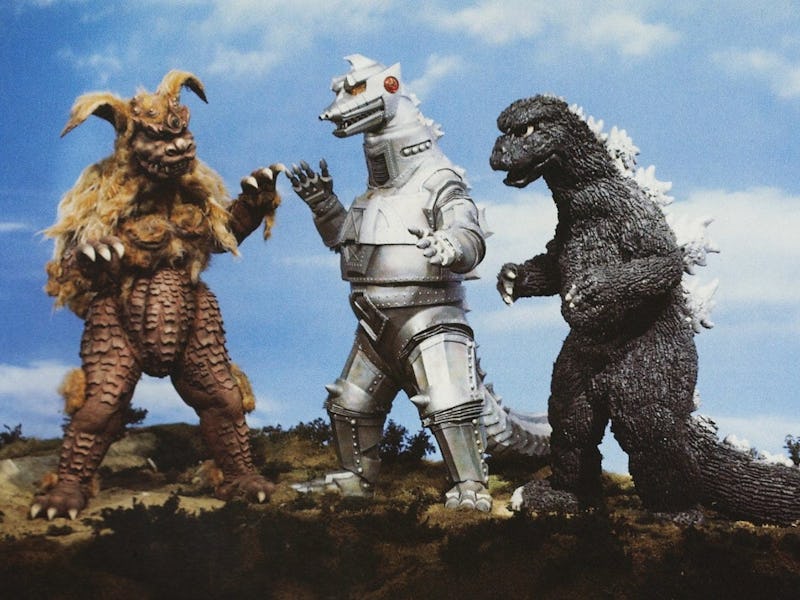Godzilla’s Most Infamous Foe Changed Pop Culture Forever
Let them fight.

In the climactic showdown of 1974’s Godzilla vs. Mechagodzilla, all hell breaks loose in Okinawa. Rainbow eye beams whirr through explosions as orange lightning zaps between clouds of billowing smoke. Finger rockets fly as giant dinosaur blood spurts. And the limbs of an enormous dog-monkey creature — a lesser kaiju named King Caesar — flail as deafening roars match Masaru Sato’s bombastic score. It’s a level of pandemonium that rivals even the great monster melees of 1968’s Destroy All Monsters, and at the center of it all is one of the most iconic combatants of the entire kaiju canon: Mechagodzilla, a weapons-laden mega-lizard built from near-indestructible “space titanium.”
A cult figure from the outset, Mechagodzilla would warrant a second title fight with Godzilla only a year later, cementing his legacy in 1975’s Terror of Mechagodzilla. He’d return to battle again in movies like 1993’s Godzilla vs. Mechagodzilla II, 2002’s Godzilla Against Mechagodzilla, and even 2021’s MonsterVerse entry Godzilla vs. Kong. But the mighty metal juggernaut, who celebrates the 50th anniversary of his debut this month, has a more nuanced origin story than his hulking figure may suggest. Not just a weapon of mass destruction unleashed via a volcanic reaction inside Mt. Fuji, he’d be a key live-action manifestation of a wider pop culture trend in early ‘70s Japan, with the now-ubiquitous mecha having an indelible mark on visual media.
At the time of Mechagodzilla’s debut, “mecha” was already a signifier for giant, biomorphic machines, distinguishable from your average robot by the presence of a manable cockpit or piloting apparatus (the Mechagodzilla of 1974 is remote-controlled by ape-like space aliens). Though typically formidable and boasting tank-like resilience, the mecha of the ‘70s emerged from more modest origins, with the diminutive mechanized karakuri (“mechanism”) puppets of 17th-century Japan among the earliest ancestors of the giant battle-bots found centuries later.
In Western media, H.G. Wells’ War of the Worlds would offer an early example of the up-scaled mecha prevalent today, with the sci-fi classic introducing giant tripod machines manned by Martian operators during an invasion of Earth. In Japan, meanwhile, the 20th century would see proto-typical superhero Ōgon Bat (“the Golden Bat”) fight giant robots at sea after he debuted in traveling kamishibai (“paper theater”) productions in the early 1930s. He’d make the jump to manga soon after, as World War II saw the kamishibai decline in popularity. In its place, a major trend would emerge.
Just as Godzilla was born from the ashes of nuclear destruction, so too would fiction that combined a metallic debris aesthetic with themes of technological growth proliferate during Japan’s post-war economic recovery. Osamu Tezuka’s Mighty Atom (1952) and Misuteru Yokoyama’s Tetsujin 28-go (1956) were among the most notable mecha fictions. The former, a futuristic, Pinocchio-esque tale about a brilliant android with human emotions, was adapted as the first giant robot anime in Japan in 1963, and was exported to the US as Astro Boy the same year. The latter, concerning a boy who controls a giant man-machine initially conceived as a weapon, followed shortly after, and arrived in the States as Gigantor in 1966. These were the foundations for the mecha anime trend that soon followed.
Mechagodzilla comes from a long, proud line of Japanese mecha.
As Japan’s post-war economic miracle moved from recovery to soaring growth in the ‘70s, so too would the mecha charge towards significant small-screen popularity. One of the most influential manga and anime series of this time was 1972’s Mazinger Z, written by Go Nagai. Like Mechagodzilla, its central figure was constructed from a metallic super-substance (called Super-Alloy Z) only found at Mt. Fuji. It was the first series of its kind to feature a protagonist piloting the machine from inside, and this concept became explosively popular thereafter, with cult productions like Reideen the Brave, Dino Mech Gaiking, and, most notably, Mobile Suit Gundam all debuting in the years that followed.
Meanwhile, the Godzilla franchise had become stagnant, with villains like Gigan and Megalon failing to set the box office alight. Toho Studios had a creative problem, but the answer was right in front of them. Mechagodzilla, who upped the ante with his 160ft, 40,000-ton presence, was partly inspired by Mechani-Kong, King Kong’s robot double who featured in the disastrous 1967 feature King Kong Escapes. The new villain was likewise fitting for Japan’s nascent technological aspirations, and though the 1974 movie proved to be a marginal financial improvement on its predecessor, it marked a major cultural breakthrough for mecha characters.
More recently, Mechagodzilla played the villain in 2021’s Godzilla vs. Kong.
The mecha would retain a permanent presence in Japanese pop culture thereafter, and would arrive in the West in the form of the AT-AT walkers of The Empire Strikes Back and the P-5000 Work Loader Ripley uses to fight the xenomorph Queen in Alien. In video games, Hideo Kojima would use bipedal tank constructs as a key proponent of the Metal Gear series, while Imperial robots and BattleMechs engaged in combat on the tabletop via the Warhammer 40,000 and BattleTech series. Even Western animation would have its own take on the concept, as Barbra Streisand took on the form of a gigantic, mechanical destructor in a 1998 South Park episode.
But as everyone from SpiderMan’s exoskeleton-enriched Doc Ock to the titanic shapeshifters of Transformers and the gargantuan Jaegers of Pacific Rim can testify, the torch of Mechagodzilla’s infernal cinematic breakthrough burns brightest today on the big screen. And so it’s a birthday worth celebrating for the big, cybernetic super-weapon — just be sure to stay away from his massive chest cannon as he blows out the candles.